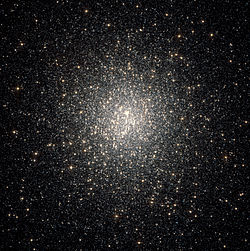| NGC 2808 | |
|---|---|
 A Hubble Space Telescope (HST) image of NGC 2808 | |
| Observation data (J2000 epoch) | |
| Class | I [1] |
| Constellation | Carina |
| Right ascension | 09h 12m 03.10s [2] |
| Declination | –64° 51′ 48.6″ [2] |
| Distance | 31.3 kly (9.6 kpc) [3] |
| Apparent magnitude (V) | 6.2 [4] |
| Apparent dimensions (V) | 13.8′ [4] |
| Physical characteristics | |
| Mass | 1.42×106 [3] M☉ |
| Metallicity | [Fe/H] = –1.14 [3] dex |
| Estimated age | 10.2 Gyr [5] |
| Other designations | GCl 13, Melotte 95 [6] |
NGC 2808 is a globular cluster [6] in the constellation Carina. The cluster currently belongs to the Milky Way, although it was likely stolen from a dwarf galaxy that collided with the Milky Way. NGC 2808 is one of the Milky Way's most massive clusters, containing more than a million stars. It is estimated to be 12.5 billion years old.
Contents
The cluster is being disrupted by the galactic tide, trailing a long tidal tail. [7]